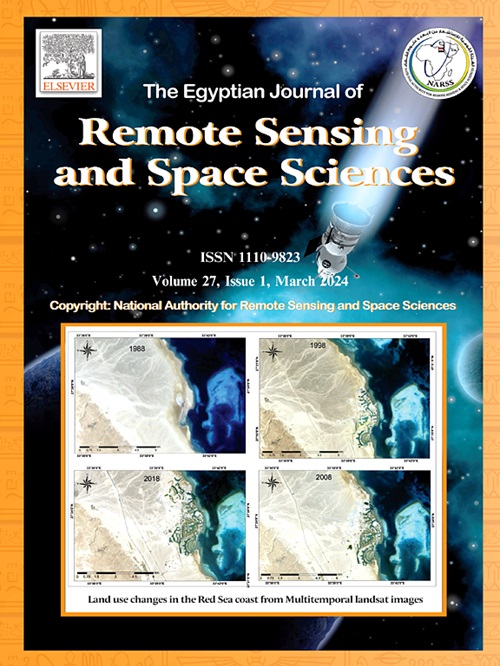用于泥炭地火灾和安第斯岩火山活动的天基中波红外摄像模块
IF 3.7
3区 地球科学
Q2 ENVIRONMENTAL SCIENCES
Egyptian Journal of Remote Sensing and Space Sciences
Pub Date : 2024-09-30
DOI:10.1016/j.ejrs.2024.09.001
引用次数: 0
摘要
印度尼西亚普遍存在两种主要的周边灾害,即泥炭地火灾和与安山岩有关的火山活动。因此,印尼政府将预防和减轻这两种灾害列为优先事项。印尼卫星技术研究中心-国家研究与创新局随后将该计划作为卫星有效载荷项目实施。在本研究中,我们介绍了天基中波红外(SMWIR)照相机模块的设计,该模块用于监测泥炭地火灾和与安山岩相关的火山活动。利用光谱范围作为设计基础,并采用设计照相机一般步骤的迭代过程,成功设计了 SMWIR 照相机模块。首先,通过四种确定光谱带方法的交叉获得了光谱范围。随后,使用 Zemax 对光学部分进行了设计,采用了三个标准来分析光学性能,如光斑图、包围能量和调制传递函数(MTF)。之后,通过 SOLIDWORKS 软件实现了机械设计。第四步是结构或热设计,由 Thermal Desktop/SINDA FLUINT 和 Zemax 完成。在电子部分,开发了照相机和探测器。最后,在模块上指定了一个校准系统。图表、图片和表格形式的结果表明,所有既定条件,包括技术方面的条件,均已达到。因此,该模块在图像、耐用性、传输和热稳定性方面都能轻松实现高性能;此外,该模块还具有可行性、重量轻和结构紧凑等特点。本文章由计算机程序翻译,如有差异,请以英文原文为准。
Space-based mid-wavelength infrared camera module for peatland fires and volcanic activities of Andesite rock
Two major perenial disasters are prevalent in Indonesia, namely, peatland fires and volcanic activities associated with Andesite rock. Thus, the Indonesian Government has prioritized the prevention and mitigation of both disasters. Indonesia’s Research Center for Satellite Technology-National Research and Innovation Agency then implemented the program as a satellite payload project. In this study, we describe the design of a space-based mid-wavelength infrared (SMWIR) camera module to monitor peatland fires and volcanic activities associated with Andesite rock. Using the spectral range as the basis of design and the iteration process of general steps in designing a camera, a SMWIR camera module was successfully designed. First, the spectral range was obtained by an intersection of four methods of determining spectral bands. Subsequently, the optical section, was conducted using Zemax by applying three criteria to analyze the optical performance, such as the spot diagram, encircled energy, and modulation transfer function (MTF). Thereafter, the mechanical design was achieved through the SOLIDWORKS software. The fourth step, namely, the structure or thermal design, was achieved by both Thermal Desktop/SINDA FLUINT and Zemax. In the electronic section, both the camera and detector were developed. Finally, a calibration system was specified over the module. Results in the form of graphs, pictures, and tables indicate that all established conditions, including those of the technical side, were achieved. Therefore, high performance in terms of the image, durability, transmission, and thermal stability can easily be achieved; additionally, the module is feasible, lightweight, and compact.
求助全文
通过发布文献求助,成功后即可免费获取论文全文。
去求助
来源期刊
CiteScore
8.10
自引率
0.00%
发文量
85
审稿时长
48 weeks
期刊介绍:
The Egyptian Journal of Remote Sensing and Space Sciences (EJRS) encompasses a comprehensive range of topics within Remote Sensing, Geographic Information Systems (GIS), planetary geology, and space technology development, including theories, applications, and modeling. EJRS aims to disseminate high-quality, peer-reviewed research focusing on the advancement of remote sensing and GIS technologies and their practical applications for effective planning, sustainable development, and environmental resource conservation. The journal particularly welcomes innovative papers with broad scientific appeal.

 求助内容:
求助内容: 应助结果提醒方式:
应助结果提醒方式:


